Among the miscellaneous objects on my rather messy desk is a brown mug, with a broken handle, decorated with a frieze of dancing rabbits. This mug has sat on every desk I’ve ever sat at: I appropriated it for a pen-holder (in its already broken state) when I was a teenager, and it has travelled everywhere with me since I left home at the age of 18. There were many similar brown mugs in our house when I was growing up: one was decorated with elephants, one with chickens, one with a Welsh dragon, and one with a partridge in a pear tree. The mugs were made by Hornsea Pottery and, since the turn of the 1970s (when she got married) my mum had purchased them one at a time, when money allowed, from Ivesons, the department store on Drake Street “that furnished half of Rochdale”.
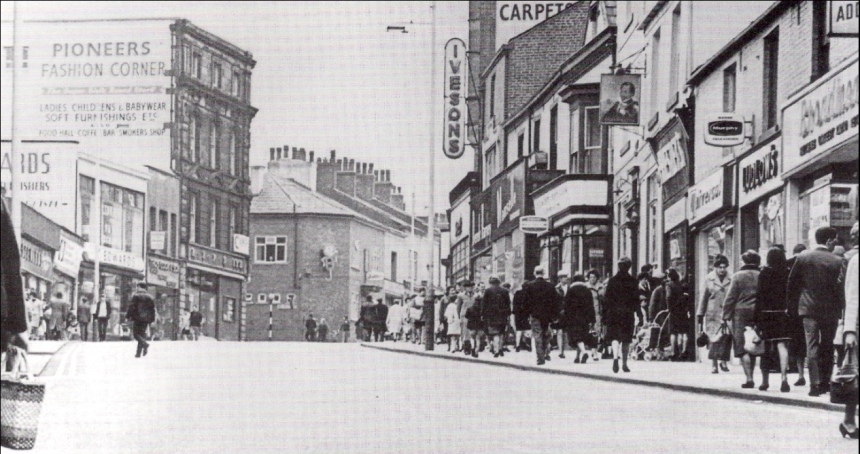
(Ivesons in its heyday. The four storey building was demolished in 2013.)
I’ve always had a fondness for my rabbit mug, and for Hornsea pottery in general. Hornsea is a seaside town in East Yorkshire, and the pottery there is of relatively recently ilk, being founded in 1949 by Colin and Desmond Rawson. In difficult post-war economic circumstances, the Rawson brothers slowly built up their business making novelty items, (such as Toby jugs and sentimental animal figures) in a kiln at the back of their house. A couple of decades later they had expanded to factory size, and achieved considerable success mass-producing interesting and attractive tableware (with the help of their innovative designers). By the late 1960s, Hornsea pottery sat on the kitchen tables of countless ordinary British households, with their “Heirloom” and “Saffron” ranges among the immediately recognisable icons of the period’s popular design.
Last year I began reading about British ceramics in the 1950s and 60s, and discovered a new interest in Hornsea pottery. I looked at my broken rabbit mug with new eyes: I had always liked the movement, character, and simplicity of its jolly repeating figures, but to me it now seemed to epitomise what Lesley Jackson said about the democratisation of post-war design through the use of familiar motifs and mass production.* I began looking for for other Hornsea mugs. It wasn’t hard to find them.
This tankard from 1970, commemorating the 350th anniversary of the Mayflower and holding exactly a pint, rapidly became my favourite tea-drinking vessel . . .
. . . I found saffron and fish mugs . . .
. . .mugs decorated with ‘newsprint’ owls . . .
. . . and another jolly rabbit mug, without a broken handle.
Then I discovered that the Hornsea designs I most admired were the work of one man, John Clappison.
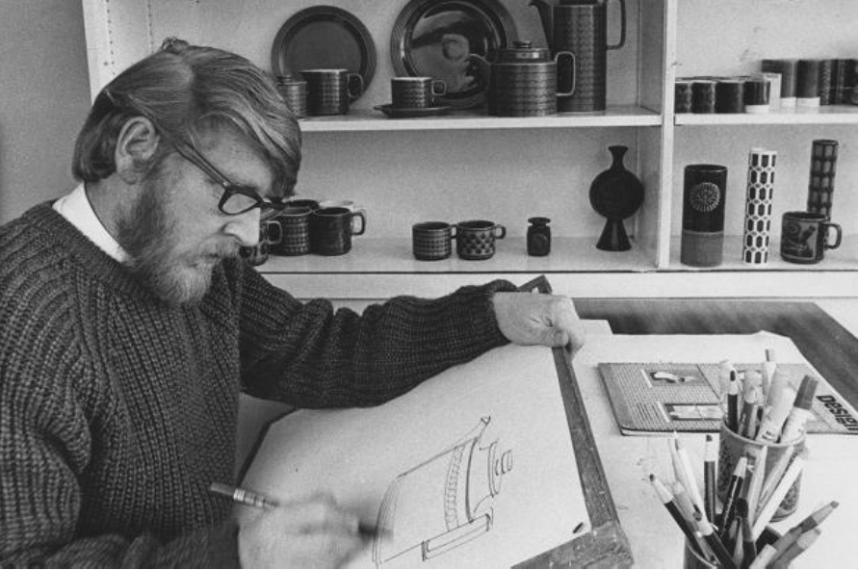
(John Clappison, at Hornsea. He also uses his mugs as penholders!)
The brown mugs and tablewear were familiar to me from my childhood. But the work Clappison produced for Hornsea pottery earlier in the 1950s and 60s was new to me, and I found really liked it.
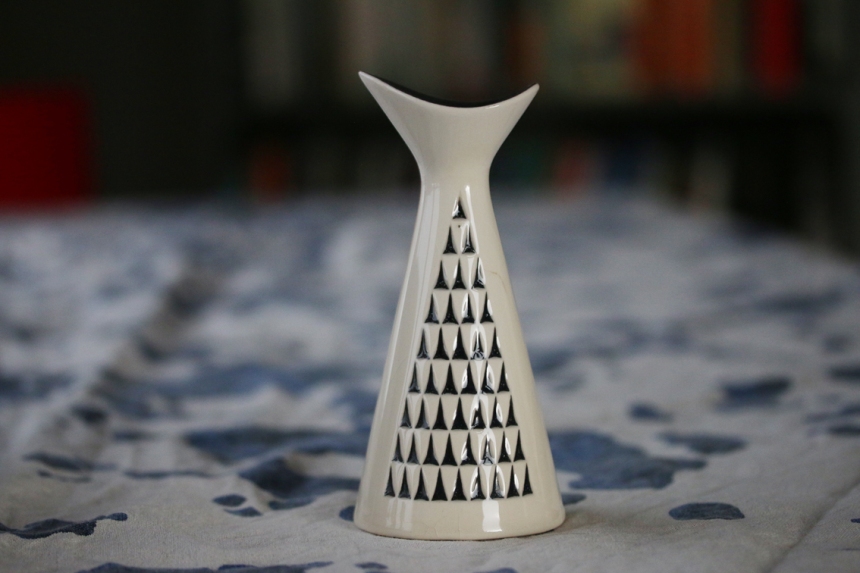
“Alpine” vinegar bottle, 1960.
Clappison’s early work for Hornsea had clean, curving lines and a simple (but innovative) use of texture and colour. In 1962, he travelled to Sweden, where he met Stig Lindberg and Gunnar Nylund and visited Gustavsberg. The designs he produced on his return to Hornsea seem to display the influence of popular Swedish ceramics, coupled with the quirkiness and economy of line that seems distinctively him.
“chicken” ashtray, 1965
When I look at what I like and admire in mid-century popular design, and indeed at what I most like to design right now myself, I think perhaps that John Clappison, out of whose mugs I drank throughout my early childhood, has somehow exercised an unconscious influence. I like simple repeats and folky motifs. I like fine lines and bold curves and blocks of colour on a background of another single colour. I also like designs which clearly have a sense of fun and vim. Clappison’s surface designs for Hornsea have all these things in spades, and I think perhaps that the influence of him and his design milieu is there somewhere in Ursula, in Peerie Flooers, and perhaps in Neepheid too. Consciously now, I am working on a design that explicitly recalls one of the lovely, simple pieces of Hornsea pottery I now own (of which more soon). John Clappison died in 2013. I wish I could have thanked him for the inspiration.
*Lesley Jackson, The New Look: Design in the 1950s (1991)
For more on Clappison see Pauline Coyle, Gone to Pot: the Life and Work of John Clappison (2007). This book is the most reliable guide to Clappison’s work (which I’ve found frequently misnamed and misattributed in other books about Hornsea Pottery)


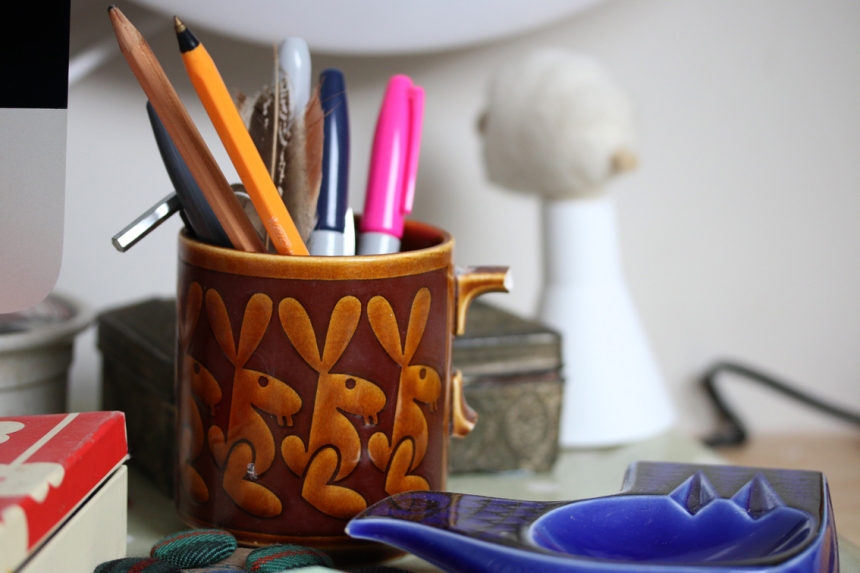
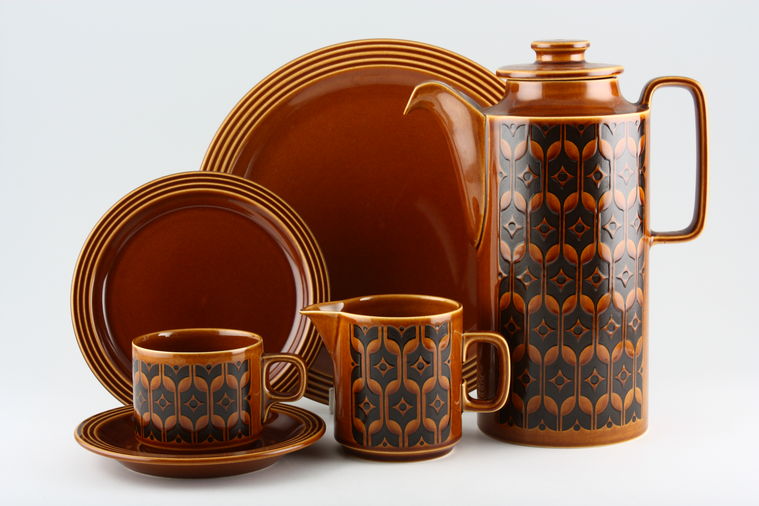
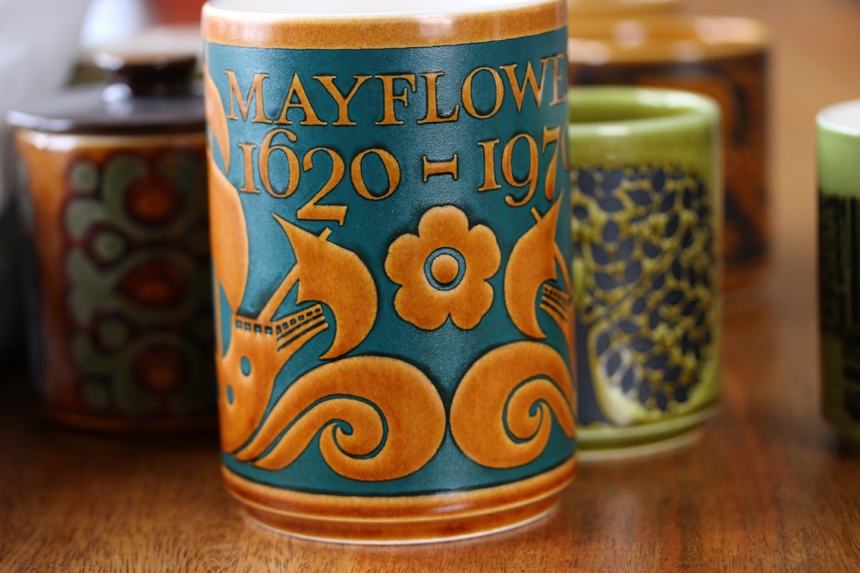

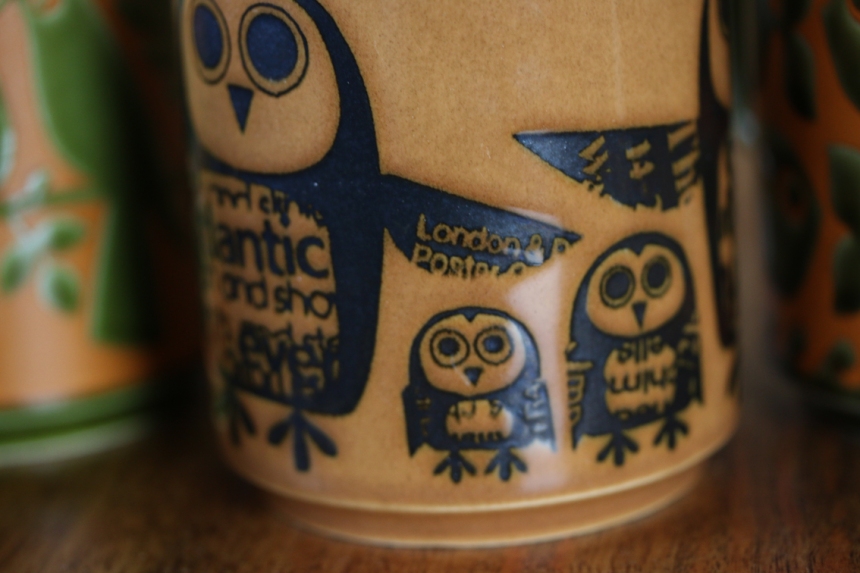

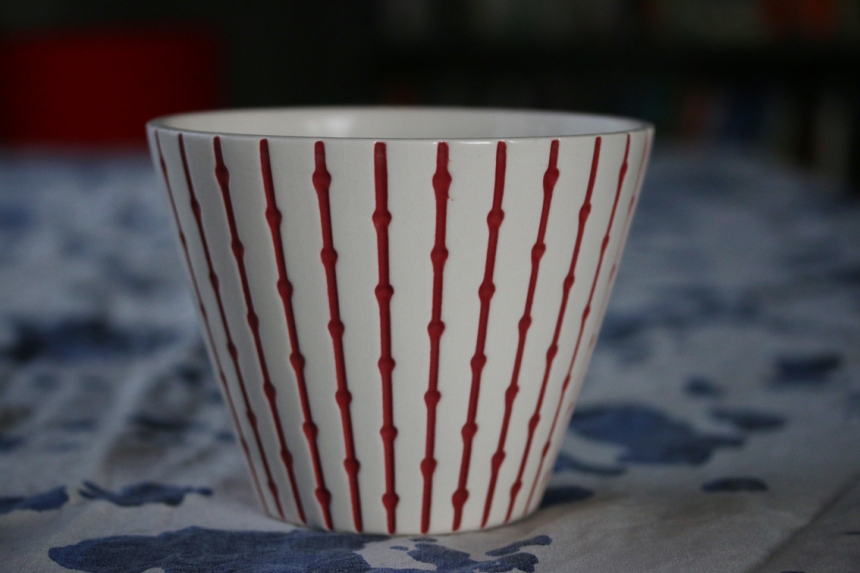
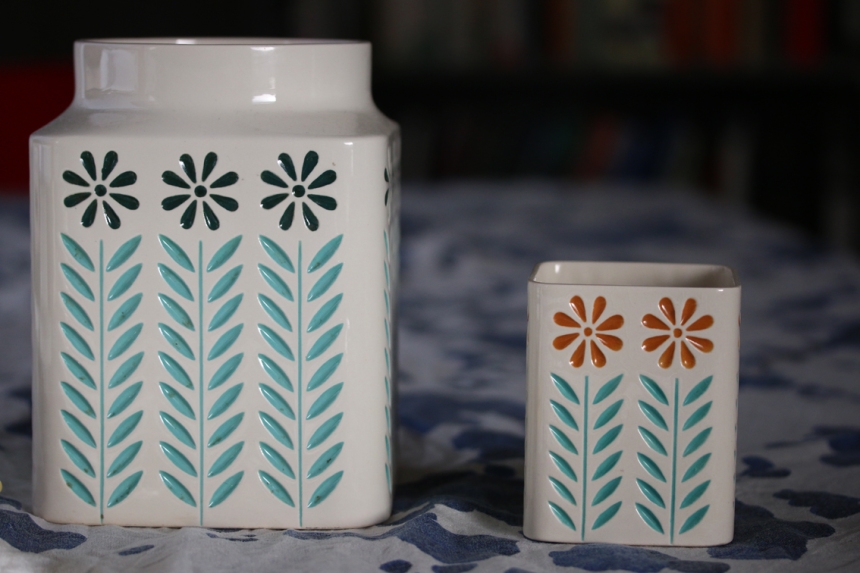
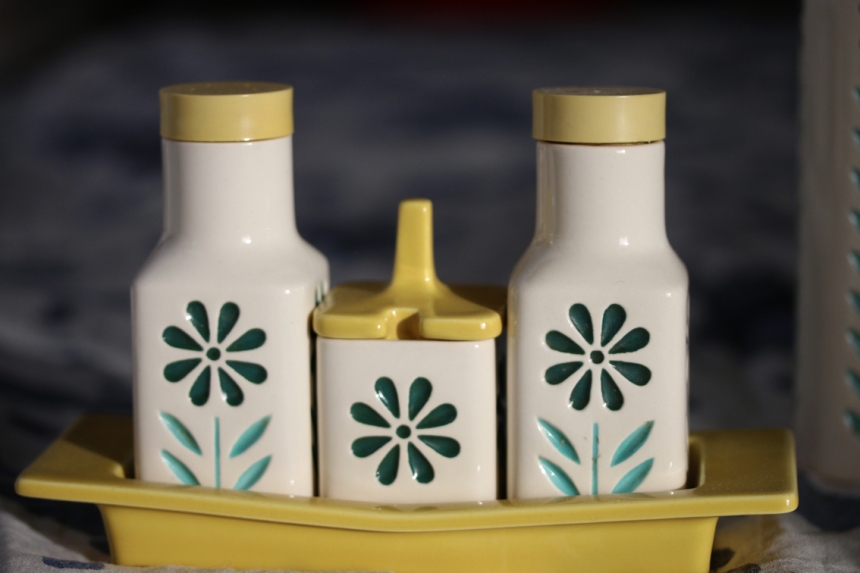
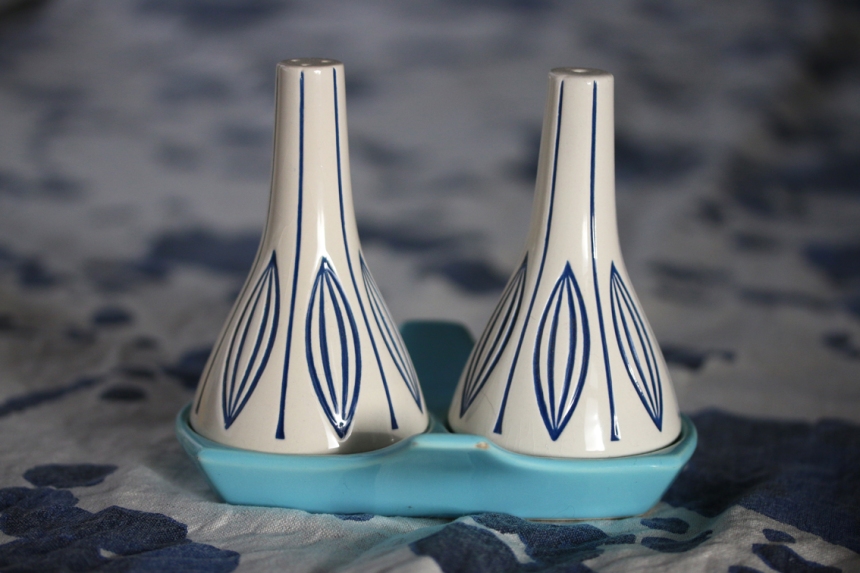

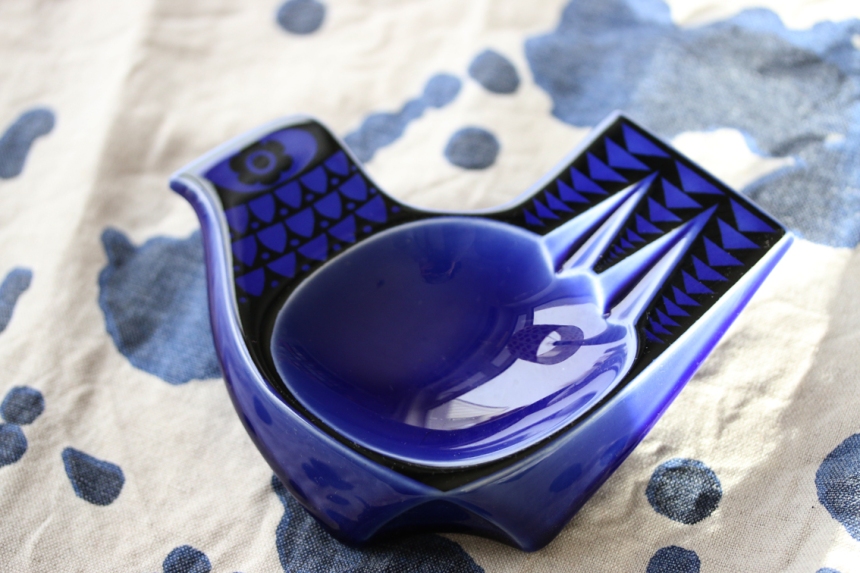
My Nain has the entire heirloom brown set, from the plates to the cutlery, the cups to the tea and coffee set, plus the salt and pepper shaker they are all there in the entirety. Loved these growing up and still love them now
LikeLike
Picked up and placed a dish meadow crowfoot back on my sideboard. Lived in Hornsea from 1963 so visited the potteries many times. My stepfathers first wife started with the potteries from the beginning I was told. Had many pieces and sold them on, but still have a few pieces left. A lamp base which was seen by the pottery society designed by Mr. Beadle I still have. Lots of memories of the early pieces in my mums and grandmas homes. I have the Hornsea Pottery book signed by Colin Rawson and Brian Heckford. Lots of names mentioned inside of people I was with at Hornsea School.
LikeLike
Many happy memories of daytrips to the pottery, so my mum could add to her collection. I think it was saffron. Always included fish n chips for lunch!
LikeLike
Thank you, Kate, for this delightful post. My mother still lives near to the pottery and will love the book about John Clappison which I have just ordered for her. She still uses a lot of Contrast tableware and I still have my favourite “train” mug when I visit her. I still use my “Lemsip” mug when I have a cold. I worked in the packing dept of the pottery for five summers in the late 70s. I always remember looking forward each June to see what new designs would be there to be admired over the summer. I was a great fan of the signs of the zodiac mugs, even if they were tiresome to pack because of the different quantities that were needed for each order. It’s also lovely to see in the comments from people who bought Hornsea Pottery from Hudsons Bay in Canada and New Zealand – I remember packing orders to such places!
The only sad note is that only the shopping mall still exists. The factory was razed to the ground quite a few years ago to make way for a very uninspired housing estate.
LikeLike
Thanks for sharing this. I love Hornsea too, and like you find the John Clappison designs appealing. But, my all time favourite is Sara Vardy’s Tapestry design.
LikeLike
Hornsea Pottery designs span just over 50 years and include the work of several talented designers and modellers. Their work lives on through the collections and treasured pieces of hundreds of people around the world. Hornsea Museum, in Hornsea, UK has 2000 items of Hornsea Pottery on display as well around 4000 items in the archive. A good place to visit if you want to experience the full glory of their award winning pottery.
LikeLike
I subscribed to your blog long ago for the inspirational knitting stories, but have come to love it for the wide variety of beautiful things you share with us. I live on a sailboat in the U.S. and had never heard of John Clappison or Hornsea. Now, I’m hunting for a special piece to call my own :) THANKS for your lovely writing and photos. Keep up the great work!
LikeLike
I’m fond of Hornsea too – I’ve got the chicken ashtray, and my fella has got a whole load of 70s Hornsey storage jars, and some not quite so tasteful 80s tableware inherited from his Grandma. I can see Hornsea in Orly Kiely designs too. Generally I go for 30s and 50s ceramics I love the bright colours and abstract ‘space age’ designs of the 50’s and the muted oranges and greens of the 30s. Love the idea of knitwear inspired by ceramic designs.
LikeLike
Hi Kate, I have a collection of Hornsea pottery pots, I live not far from Horsea and when I visit the seaside there I always look in the museum windows at all the beautiful designs on their collection of pots from the pottery
LikeLike
Great post. I toured the Horsea Pottery in the early 80’s on one of my many research trips studying English pottery and porcelain. The work then was quite different but still very strong design-wise.
The first image following the photo of the department store….the coffee set; have you started charting it yet? Will it be a yoked pullover or a cardigan? Or would that be intellectual property infringement?
LikeLike
The heirloom pattern is already incredibly similar, I think, to many Icelandic yoke designs, created during the same period. I find these structural consonances between different media fascinating! The pattern I’m currently producing is inspired by one of Clappison’s — visibly recalling it but certainly not reproducing it.
LikeLike
Oh memories. I got married in 1970 and we had collected a whole set of the orange flowered pottery. It got broken, then our daughter had the rest when she moved out, I think she’s still got a couple of coffee and tea containers. That was then, though. We’ve moved on in the meantime. You can’t always dwell on the past.
LikeLike
I love these posts! And isn’t it remarkable how certain color combinations or design forms from our comfort spot stay with us? Most of my Mother’s family worked for a famous glassworks at one time or another. Most of those designs I grew up with are mimicked in items I purchased new as an adult.
PS…those ashtrays..so cute!…may make great stitchmarker holders or even yarn bowls…or Bruce snack bowls. (He asked me to mention it)
LikeLike
I’ve seen this pottery around, I remember the Saffron set in the 70’s when I was growing up, a couple of friends Mum’s had some if it. I really liked it and I also seem to like the designs by John Clapperson too, without actually realising that the pieces I liked so much were by the same person. There’s a Springtime Sugar/Preserve Lidded Jar on Ebay right now and whilst it’s cheap, it probably won’t stay that way! And although a lot of people go mad over Orla Kiely’s work, I think you can see a lot of John Clappison in her style, but I’ve never seen her credit him. I adore stoneware and earthenware over fine china and have quite a lot of Highland Stoneware in the Celadon Floral range and a few in Seascape. Of course, they’ve now added the Sheep range too!
LikeLike
I too have a piece of Hornsea pottery on my desk. It’s a pencil pot, and I’ve had it on every desk I’ve had since I was about 16 (so that’s over 30 years). I can’t wait to see what you come up with as a Hornsea-inspired design. :-)
LikeLike
Oh love this post, I have apparently a hornsea tea pot and cup
LikeLike
We had the Heirloom tea, sugar and coffee set. Such a nostalgic pattern for me. I did not know anything of the history, so thank you.
LikeLike
Thanks for introducing me to this ceramics line (and its designer); such awesome graphics. I’ll be keeping my eyes open for examples of these.
LikeLike
Thanks so much for introducing me to Hornsea pottery. I had never heard of it, but now I have ordered a John Clappison chicken mug off Etsy.
LikeLike
Very interesting post, Kate. It combines several of the things I love most. I’m going to look for the book about Clappison, seems like a very interesting read. Do you know Sargadelos ceramics? It came to my mind reading this. It’s ceramics and porcelaine from the Northwest of Spain. Beautiful designs (to my eyes at least), sth very 60s and 70s about them, simple lines, geometric and repetitive, very schematic. Blues and browns. Some with a bit of red which made them expensive given the complexity of the process. A ceramics factory with a different cycles and renaissances too. In my parents´ time almost every household in Spain had at least a piece of this. So childhood memories for me too. A bit of the emotional equivalent maybe…
LikeLike
I had the elephant mug and the Dragon mug and loved them too. My handle fell off but it became a much-loved pencil holder during college. I’m visiting home again soon and I’ve a mind to look in the old cupboards to see if anythings there. Thanks for the post with so much interesting information!
LikeLike
Lovely post. During my teens in Cornwall my Mother loved Hornsea Pottery items and these pictures takes me back. In one of life’s twists of fate I now live in Beverley, East Riding, just up the road from Hornsea (the Pottery long gone – now a naff shopping outlet) and know a number of the Clappison family. They are all farmers rather than designers. The pottery items seem more rare around here than you’d expect.
LikeLike
Stripping Peerie Flooers down to two colors really underscores the Clappison influence on your work. Lovely!
http://www.ravelry.com/projects/mermade/blaithin
LikeLike
Loved reading your article and looking at these beautiful designs. Thanks for sharing it with us! =)
LikeLike
Such a pleasure to see an entry on Hornsea Pottery, being an East Yorkshire lass myself. Every family had some growing up around here and I delight in seeing it pop up in charity shops for very reasonable prices since it is generally [sadly] considered to be such an ordinary, “bog standard” affair. It’s the Tapestry pattern that adorned our table (and house!) as children.
LikeLike
Great post ! I can totally see why you’d fall for his designs; they are wonderfull !
It makes me quite curious what new design you are working on :)
LikeLike
Thank you for this very informative post. My childhood was surrounded by Hornsea, yet I didn’t know. Mum still uses a full (battered) set of the space jars. Now I know where to get hold of them. Love your rabbit mug.
LikeLike
I remember these…we had some too. I think they were my grandmother’s best set that came out on special occasions.
LikeLike
Oh, I had the fish mug! Thanks so much for the happy flashback and fascinating insight into the design x
LikeLike
Some of his work is very “Scandinavian” in appearance. You’re so right about “simplicity”.
And what is it with academics and former academics and the need for over-size mugs? (Says she peering over the top of her mug with the mousing cat on it.)
LikeLike
I can see exactly how you have an affinity with these pottery designs. The lines, the motifs, the colours, are so reminiscent of your own work. Looking forward to seeing what you’ve come up with from this inspiration.
LikeLike
Really enjoyed your story–and the pottery is so whimsical, and somehow comforting.Can’t wait to see what designs you will be inspired to come up with!
LikeLike
Oooo. Check out William by Ann Kingstone over in Ravelry. Patshere made a beautiful one. Ran across it while looking for colorwork combos right after reading this wonderful post!
LikeLike
As my mum has gotten rid of pieces she no longer has any use for, I have been giving many of them new homes – mostly mid-century Swedish pottery. After reading your post, I took a second look at Mum’s old lolly jar and it turned out to be Hornsea! Thanks for giving me a broader context for this much-loved piece of my childhood.
LikeLike
Thanks for the information on Hornsea china. When first married and earning money in the 70’s we bought a set of Saffron at the Hudson Bay northern store in Thompson Manitoba Canada. It was our daily china for about 20 years. We added to replace through “garage sale” purchases and ended up with serving bowls, flower vases, egg cups and a teapot. When we moved back to Vancouver, we eventuallly sold it to a collector, keeping only the four cannisters. What a nice journey down memory lane, especially seeing how many of us, especially you, Kate, have been attracted to the elegant designs.
LikeLike
There is the American artist Charlie Harper whose print works seems to be undergoing a renaissance in the US. It has some similarities to the designs you’ve shown. Also from 50-60’s
LikeLike
Sat here in Cornwall. Showing my husband your blog. We love Hornsea. I have the green and orange bird pot next to me on the table. A great feature.
LikeLike
I have a few beloved pieces of Hornsea, in the growing collection of ridiculous 70s crockery from charity shops. In New Zealand it’s hard to find, but occasionally I pounce on something reminiscent of the curtains at my primary school. If I found a piece of Hornsea with the dinosaur design I’d think I’d died and gone to heaven.
My collection has a lot from Crown Lynn and the other West Auckland potteries that closed in the 1980s, which often had local motifs like ferns and Maori designs.
LikeLike
I think you may have found my new love. Thanks,Kate. x
LikeLike
Thanks Kate. What an education this post has been. I’ve just come to realise that we store our porridge oats in a Hornsea jar. How lovely.
LikeLike
What an interesting post. I have an enduring interest in pottery and ceramics and feel they are a very non threatening and democratic introduction to design. Democratic because everyone needs pots and non-threatening because only a very acetic soul would judge you on your choice of mug.
It was through ‘pots’ that I began to look at all objects around me and think about design. My aunt – well travelled and sophisticated – had Denby, and the Arabesque pattern (mine now) was a huge contrast to the maroon and gold banded items we had in our house.
I love absolutely everything about pots. From Edmund de Waal to Bernard Leach to Julia Roxburgh and every flower pot in between, there’s so much skill to admire. I love its solidity and its fragility – how it can go from whole to broken in a split second. I love how it can be mass produced and predictably good and how it can be handmade and wonky and utterly individual.
I love pots.
That chicken ashtray is beautiful.
LikeLike
Lovely post and lovely pottery! Thanks for the inspiration!
LikeLike
Love the rabbits and the flowers, can’t wait to see how they influence your design. Thank you for this lovely and informative post, I shall be keeping a look out for Hornsea pottery – I really like those owls.
LikeLike
As a Yorkshire lass I have such mixed feelings about Hornsea pottery. When we married in 1970, practically penniless, our best man came from Hornsea and when we visited him we used to buy a few seconds from the factory to build up a decent dinner service. I’v spent most of my life eating off saffron coloured plates and using the various mugs. I still have a few pieces, nothing like the beauties you show, but I gave most of my items to charity when we downsized last year. You can’t say the stuff wasn’t durable and it certainly served us well but I’m not actively searching for more. Lovely post, thank you.
LikeLike
Wow! I recognise the owl mug. Along with a matching elephant mug they were probably the first two mugs I owned when I left home and that’s a very long time ago!
LikeLike
I have a mug with two monkeys with descriptions of Gemini attributes that I’ve had since I was a kid. I didn’t think about t who it was made by until I saw the picture of the owl mugs (similar style). I’m rather paranoid about it breaking although that doesn’t stop me giving it to my six year old to drink her tea from. They are lovely designs.
LikeLike
What a lovely post. I remember my mum having the Saffron pottery, and recently my daughter has collected some dark green designs. I was at Lancaster University in the 1970s, and remember visiting a factory shop quite nearby – can’t remember exactly where. (Just noticed it is mentioned above!)
I have some Orla Kiely storage containers and mugs which draw on Scandinavian styles I think. The other thing that I’ve collected started with a cream jug that my mum had (Motto – Ga canny with the cream)- Torquay pottery/ Devonware. I don’t really use it, but just love to see the cream/blue/green colours. Sometimes it has a ‘Scandi’ pattern but not sure if that is meant to look Scandinavian! I think that one of the artists had previously worked at Wemyss, and the cockerel patterns on some are a bit reminiscent of Wemyss ware, (Can’t afford originals there, but I’ve got some small Griselda Hill items.)
Wearing my Ursula today too.
LikeLike
Kate, What an interesting post. The whole time I was reading it, I was thinking what will Kate design from Clappison’s work. I am intrigued!
LikeLike
Lovely. My wedding china in the 1970s was Hornsea Contrast, and eventually I had quite a lot! Oh, those far off days! There was lots to chose from, and it was all marvellous!
LikeLike
Love this post, esp the history and the picture of the black and brown coffee pot with the creamer and cup and plates! I’d enjoy using any of these pieces. Thanks.
LikeLike
I always enjoy your posts when you teach us something new. I love the history behind the ceramic designs & I’m going to be lurking in eBay to see if I can find some of these mugs. Just before you admitted that some of your designs were subliminally influenced by the Hornsea designs, I was already seeing knitting patterns there & thinking of the designs you mention. Don’t you think Felix will also be jumping to her sketch pad once she reads this post? Thanks again for a most enjoyable post. It made my day & inspired me to my graph paper after laundry gets done today.
LikeLike
Thank you, Kate. I loved this post! I am currently working on the Owligan and was immediately reminded of all of your owl patterns while reading this. I was thinking that the color inlay ashtray would make a great yoke.
LikeLike
Hi Kate,
You’ve taken me right back to my family’s kitchen in the late seventies early eighties. We had a couple of small jars for tea bags and sugar, and a big jar that was always full of some sort of biscuit……I can almost hear my dad asking if one of us girls would put the kettle on him and then grumbling about who had been eating all the biscuits…..John Clappison’s work is so familar, very homey feeling and smile inducing. I can’t wait to see your knitting inspired by his designs.
LikeLike
I really enjoyed this post, Kate, and am looking forward to seeing your new design. I chuckled when I read that you drink your tea out of a pint mug. :-)
LikeLike
What a treat it was to read your nice story this morning. And for you to find similarities between your designs and having been influenced unknowlingly by Clappison’s designs from your childhood. I too have had the same revelations of being influenced in this way. In a high school art class I painted an adobe style corner fireplace. Decades later my mother gave me some old Arizona Highways magazines from the 1950’s and in one issue was the nearly identical photo of the adobe style fireplace I had painted. It was a real surprise for me. And yes, some of your designs do seem to reflect a Clappison influence. How cool can that be . . .
LikeLike
Nice to see your collection of Hornsea Pottery pieces Kate. I have a cruet set and a jug in the Heirloom pattern. A jam dish did not survive. Also have three “Cannisters” in Bronte pattern. We bought them when there was a Hornsea pottery near Lancaster and enjoyed outings there when our children were little. The attraction for them was mainly the animal enclosures outside the pottery buildings. I think D still has the novelty “Loony” mug we bought him then.
LikeLike
These designs would lend themselves so beautifully to knitting! The rabbits, the Swedish flowers, the colours…can we hope you will design some Ode to Hornsea project?
LikeLike
Oh Kate, what fun. That rabbit mug is an old friend of mine – there is one exactly like it (with handle intact) in the cupboard in my mother’s kitchen. It is one of the few survivors (I think there is also one of Snow White’s seven dwarfs) of the very first generation of mugs in our household. It takes me back to a 1960s terraced house that we left in 1971, when I was 11. Until a year or two earlier we had always had afternoon tea together as a family out of cups and saucers – two teaspoons of sugar in each one, it seems unimaginable now – but suddenly the new informality of mugs was coming in, and my mother, whose social and aesthetic sense was formed during her childhood in Sweden, took to them at once. Democratisation indeed: people would ask apologetically, ‘Do you mind having it in a mug?’ (subtext: I know it’s slumming it a bit, and I’m being lazy about the washing up, but we don’t have Help in the kitchen these days – besides, they’re rather jolly, don’t you think?) but they very quickly became universal. Your picture takes me back to that innocent time when my sister and I were children together in the late 1960s, and we would come home from primary school and have Shippam’s paste sandwiches for tea…
Thanks for all the background info. Interesting about the influence of Clappison’s trip to Sweden – I agree that it does seem visible in your photos of the work from after 1962. My mother married in 1957 and her younger sister in 1963, and they both still have pieces of Swedish ceramics given to them as wedding presents that are very much in the style of the images Google finds for Stig Lindberg and Gunnar Nylund.
My father is now dead and my mother 83 and barely able to manage alone – but that old rabbit mug is still there, doing daily service with the tea and coffee, and showing no signs of being troubled by the dishwasher powder that it can’t have been designed to cope with.
LikeLiked by 2 people
Lovely story, thank you. I enjoyed reading your comments as much as I did Kate’s post. I have a couple of mugs from my childhood that I grabbed when my mom was cleaning out her cabinets, too. They hold many memories.
LikeLike
Lovely story and memories. Glad to see you mother still has the mug!
LikeLike
Just behind the Mayflower mug is the pattern I grew up with (teapot, storage jars, spice rack…etc). What a massive whoosh of nostalgia!
LikeLike
Thanks! I was not familiar with these designs, but immediately took a liking to them! I think I need a mug!
LikeLike
Thank you so much for sharing this with us – beautiful and interesting. Looking forward to seeing what comes off the needles with this new thread of thought :)
LikeLike
ah,Ivesons, and Haworths, lovely shops. i still have furniture bought at Ivesons. I found myself scouring that photograph looking for myself or my late husband!
A little bit further down Drake street was the San Remo coffee bar where we used to hang out as teenagers, though we tended to eat at the nearby Wimpey when we had the cash.
Love your hornsea collection too.
thanks for the memories !
LikeLike
Good design is timeless! Thanks for sharing this fascinating story!
LikeLike
I hope you are working on rabbits hopping round the yoke of a sweater. That was a very interesting article, thanks.
LikeLike
ooh yes, a lovely kiddy cardigan with rabbits round the yoke..or sth with owls for all the owl fans :)
LikeLike
Warmth and whimsey are very present in each of your (both) designs and are very important in mugs and knitting. Am thinking those rabbits need to be charged…off to play!
LikeLike
Thanks so much for sharing your pleasures with us Kate. You can bet there will be a big hunt for Clappisun designs now. I can see some dancing rabbits appearing in the near future on a yoke maybe. Lovely.
LikeLike
I LOVE the planter. That would make a great basis for a knitting design. I have just started a degree with the Open University entitled “Design and Innovation”. I am saving your blogpost, I’m sure it will come in useful in the near future!
LikeLike
Interesting post, thanks for sharing. I too love the springtime design, and of course the rabbit mugs!
Caz xx
LikeLike
I really like the owls. It’s interesting to look over our shoulders and find the small bits of inspiration all around us. I enjoyed this post.
LikeLike
Interesting!
LikeLike
I see the influences of his designs in your work. Interesting… Love the motifs. Great post.
LikeLike
Those ‘Springtime’ designs are beautiful and I love the rabbits!
Looking forward to your design.
LikeLike